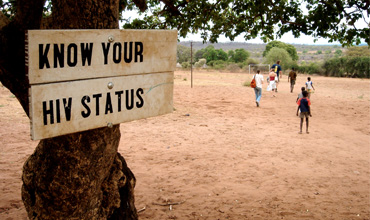Community based approach to achieving Universal Access to HIV Testing and Counseling

Abstract:
Introduction:
Achieving universal access to HIV services requires a mixture of strategies to
increase opportunities for people to know their HIV status. APIN in conjunction
with civil society organization and with funding support from Global Fund (GF)
and National Agency for AIDS Control (NACA) embarked on community HTC outreach
campaigns in Lagos, Plateau and Oyo States of Nigeria. Community entry,
advocacy and mobilization were key start up strategies.
Methods/Approach and Result: Partnership
with Civil Society Organizations with strong presence leadership roles within
the communities was the main approach to a community based approach to
increasing uptake of HTC services in the three (3) states of Nigeria where AIDS
Prevention Initiative in Nigeria operated. Eighteen (18) LGAs, 189 communities
and 154 ANC locations across three states benefited from the outreaches.
54,841(1.2% positivity rates) people among the general population and 36,061
(0.19% positivity rates) pregnant women were provided with HCT services over three
weeks.
Conclusion: Alternative
approaches to facility based HTC are critical to achieving universal access to
HTC. Community based approach to HTC that relies on strong partnerships and
collaboration with organizations that have commitments and leadership roles in
the communities can improve uptake of services. It is a veritable approach for
expanding access, availability and coverage of HTC services.
Keywords: Community, Partnership, Access, Uptake, eMTCT, Advocacy, Mobilization
References:
[1] Baggaley R, Hensen, B
Ajose, O et al. (2012). From
caution to urgency: the evolution of HIV testing and counselling in Africa. Bull World Health Organ 2012; 90:652–658B |
doi:10.2471/BLT.11.100818
[2] Bradlet et al, 2014 Vital Signs: HIV Diagnosis, Care,
and Treatment Among Persons Living with HIV — United States, 2011 Morbidity and Mortality Weekly Report (MMWR)
63(47);1113-1117
[3] Centers for Disease Control and Prevention (CDC),
Forging Partnerships to Eliminate Tuberculosis: A Guide and Toolkit Chapter 3:
What Successful Health-Related Community Partnerships Have in Common http://www.cdc.gov/tb/publications/guidestoolkits/forge/pdfs/chpt3.pdf.
[4] Federal Ministry of Health [Nigeria] (2013). National
HIV&AIDS and Reproductive Health Survey, 2012 (NARHS Plus). Federal
Ministry of Health Abuja, Nigeria. http://nascp.gov.ng/demo/wp-content/uploads/2014/02/NARHS-Plus-2012-Final-18112013.pdf
[5] Federal Ministry of Health (FMOH), Nigeria, (2014).
Integrated National Guidelines for HIV Prevention, Treatment and Care Chapter
2: Diagnosis of HIV Infection
[6] Hensen B, Baggaley R, Wong VJ, Grabbe KL, Shaffer N, et
al. (2012) Universal voluntary HIV testing in antenatal care settings: a review
of the contribution of provider-initiated testing & counselling. Trop Med
Int Health 17: 59–70.
[7] Matovu JK, Makumbi FE (2007) Expanding access to
voluntary HIV counselling and testing in sub-Saharan Africa: alternative
approaches for improving uptake, 2001–2007. Trop Med Int Health 12: 1315–1322.
[8] National Agency for the Control of AIDS (NACA), 2014a.
Federal Republic of NIGERIA GLOBAL AIDS RESPONSE Country Progress Report.
(Nigeria GARPR) available at
http://www.unaids.org/sites/default/files/country/documents/NGA_narrative_report_2014.pdf
[9] National Agency for the Control of AIDS (NACA), 2014b.
National HIV/AIDS Prevention Plan (NPP) (2014 - 2015)
[10] Shortell S.M, Zukoski A.P, Alexander A, et al. (2002).
Evaluating partnerships for community health improvement: Tracking the
footprints. Journal of Health Politics,
Policy, and Law 1: 49–91.
[11] Sibley L.M, Sipe T.A, Brown C.M, Diallo M.M, McNatt K,
Habarta N. (2007) Traditional birth attendant training for improving health
behaviors and pregnancy outcomes. Cochrane
Database of Systematic Reviews 3:CD005460. DOI: 10.1002/14651858.CD005460.
[12] SouleymaneMboup, Rosemary Musonda, Fred Mhalu, and Max
Essex (2006) Disease and Mortality in
Sub-Saharan Africa Washington DC, World Bank 2nd edition Chapter 17
HIV/AIDS http://www.ncbi.nlm.nih.gov/books/NBK2289/
[13] Suthar et al (2013) Towards Universal Voluntary HIV
Testing and Counselling: A Systematic Review and Meta-Analysis of
Community-Based Approaches PLOS 10:8 http://www.ncbi.nlm.nih.gov/pmc/articles/PMC3742447/pdf/pmed.1001496.pdf
[14] UNAIDS (2014) The Gap Report. Available online at http://www.unaids.org/sites/default/files/media_asset/UNAIDS_Gap_report_en.pdf
[15] USAID (2014) Promoting High Quality HIV Testing and
Counseling for HIV-Positive Individuals and Linking IT to HIV Care and
Treatmenthttp://www.usaid.gov/what-we-do/global-health/hiv-and-aids/technical-areas/promoting-high-quality-hiv-testing-and
[16] United Nations Industrial Development Organization –
Country Context – Nigeria (2014) http://www.unido.org/en/where-we-work/africa/offices/officenigeria/country-context.html
[17] WHO (2005) Preventing Chronic Diseases: A vital
Investment WHO global reporthttp://www.who.int/chp/chronic_disease_report/en/
[18] WHO (2012a) Statement on HIV testing and counseling:
WHO, UNAIDS re-affirm opposition to mandatory HIV testinghttp://www.who.int/hiv/events/2012/world_aids_day/hiv_testing_counselling/en/
[19] WHO (2012b) Service Delivery Approaches to HIV testing
and counselling (HTC): A Strategic HTC Programme Framework. http://apps.who.int/iris/bitstream/10665/75206/1/9789241593877_eng.pdf
[20] WHO (2015). Global Health Observatory. HIV/AIDS.
Available online at http://www.who.int/gho/hiv/en/

